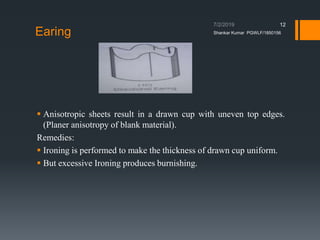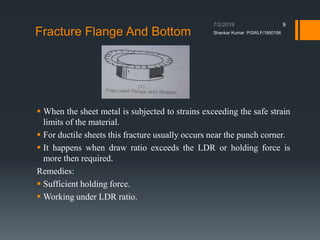The CrCN- and TiCN-coated dies did not exceed the critical average roughness in the trial although the CrCN was close after. In the deep drawing process earing is one of the most common defects that occur 22 23 where non-uniform elongation in the radial direction as a result of anisotropy of the workpiece causes a.

Deep Drawing An Overview Sciencedirect Topics
It does not provide on punch because friction between punch and blank improves draw ability by reduce tensile stress.

. The most common defects in deep drawing operations are wrinkling galling orange peeling earing and tearing. The following is a brief description of commonly found defects. A number of defects may occur in deep-drawn parts.
Excessive thinning in areas of the sheet metal is also an unwanted defect. Failure of sheet metal parts during deep drawing processes usually takes place in the form of wrinkling or tearing. In addition wrinkling may occur in the flange area in sheet spinning along the feeding direction of a flat strip under extrusion and in the circumferential direction of an annular thin film under torque.
Deep drawing defects pdf Example of deep drawn part Deep drawing is a sheet metal forming process in which a sheet metal blank is radially drawn into a forming die by the mechanical action of a punch1 It is thus a shape transformation process with material retention. Therefore it is important to optimize the process parameters to avoid defects in the parts and to minimize production cost. Effect of Surface Treatment.
Figure 12 shows the type of defects that may be found after drawing cups. Steel material must be consumed within the strain aging time of material. Shankar Kumar PGWLF1850156 7 8.
Deep drawing along with its defects advantages disadvantages and application deep drawing cup drawing deep drawing force deep drawing advantages deep. These two defects ie. Shankar Kumar PGWLF1850156 8 9.
Scratches Heavy scratches over the drawn cup may appear due to appearance of yield point phenomenon in the material. Sheet metal forming a review tms org. This defect is caused by the excessive compressive stresses if the slenderness ratio is higher than a certain value.
It occurs in. In the deep drawing process 1Cr18Ni9Ti is more stable than 0Cr18Ni9Ti and has better crack resistance. Fracturing of the metal during the draw process can be caused by several issues although the most common is the clearance between the punch and the die.
Incorrect blank shape andor size. This is one of the most common deep draw problems. Potential causes and remedies are also provided.
Mostly used lubricants in deep drawing process are mineral oils soap solutions and heavy duty emulsions. Their occurrence is related to numerous factors such as blank hardness lubrication system quality of the die surface grain size and anisotropy of the drawn material holding down pressure and clearance between the punch and die. Defects in deep-drawn cylindrical cups.
One of the primary defects that occurs in deep drawing operations is the wrinkling of sheet metal material generally in the wall or flange of the part. Grain structure should be refined before deep drawing. If this is too small too large or uneven the material can be cracked during drawing.
The process is considered deep drawing when the depth of the drawn part. Many variables affect the failure these. Defects and Remedies in Stamping of Advanced High Strength Journal of Modern Mechanical Engineering and Technology 2014 Vol.
Tearing is one of the most common defects. WRINKLES Wrinkles - caused due to excessive clearance between the punch and die. The commonly used materials in austenitic stainless steel are 1Cr18Ni9Ti and 0Cr18Ni9Ti.
The following metals are currently used to manufacture products through deep drawing Alloy Aluminum Brass Bronze Cold rolled steel Copper Invar Iron Kovar Molybdenum Nickel Silver Stainless steel Tungsten 19. The wrinkling defects are a kind of buckling of the undrawn part of the blank. Springback or final part deviation from nominal Incorrect process or number of forming tools.
Metal fractures very early in the. Excessive thinningthickening of the sheet during forming. On the other hand necking is due to the excessive radial tensile stress.
Choose the right stainless steel material. Sheet metal stamining in automotive industry. Defects and Remedies in Stamping of Advanced High Strength Journal of Modern Mechanical Engineering and Technology 2014 Vol.
All three surface treatments improved the galling resistance of the die. Wrinkling and necking define the limits of the deep drawing process. Wrinkles splits and springback are the three most common defects encountered during sheet metal stamping.
7 Kinds of Stainless Steel Common Forming Defects Prevention Measures. Development of a sheet metal component with a forming die. The flange of the blank undergoes radial drawing stress and tangential compressive stress during the stamping process which sometimes results in wrinkles.
Visualisation of surface defects in sheet metal panels. Sheet metal stamping defects deep drawing wikipedia. The description of such defects is discussed below.
E Surface scratches 6 Earing. Defects that occur during deep drawing of sheet metal can be controlled by careful regulation of process factors. The following is a list of common problems that may be encountered when deep drawing cyclindrical cups.
This chart shows surface roughness variation with the number of cycles for each different surface treatment. Develop defects if the process parameters are not selected properly. Pdf defects and remedies in stamping of advanced high.
Defects in Deep-Drawn Parts. 2 71 Over forming is a known solution for springback Splitting tearing is another defect type present in which is based on providing compensation in the the forming of AHSS from necking that starts from. Lubrication lowers the forces increases draw ability and reduces defect in the part and wear on the tooling.
Wrinkling usually occurs at the flange region by excessive compressive stresses leading to local buckling of the sheet. For sheets in the deep-drawing process wrinkling is the one of the most commonly seen defects and can take place in both the side-wall and flange area. The main defects of deep drawn parts are wrinkling andor necking.

Defects In Deep Drawing And Their Remedies

Defects In Deep Drawing And Their Remedies

Defects In Deep Drawing And Their Remedies

Defects In Deep Drawing And Their Remedies

Defects In Deep Drawing And Their Remedies


0 comments
Post a Comment